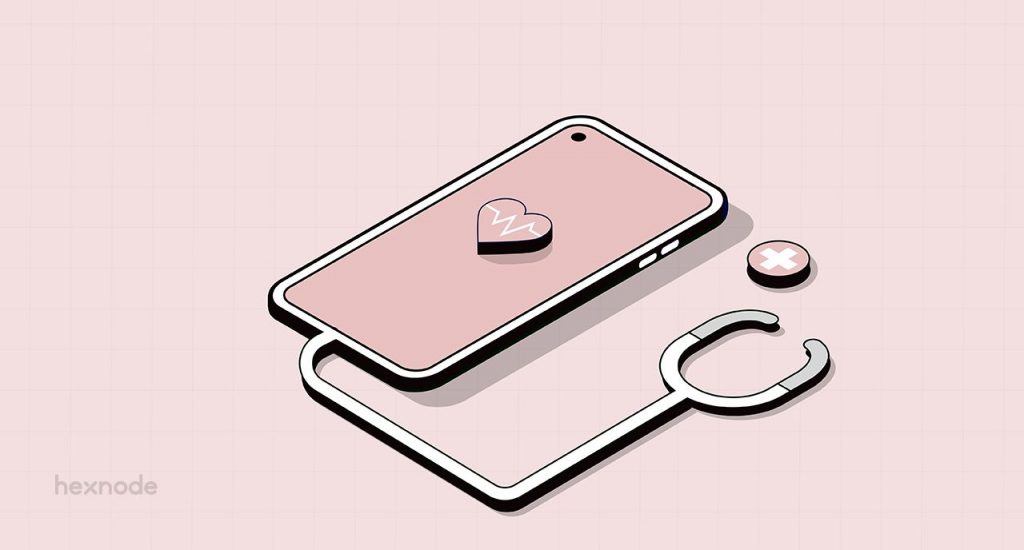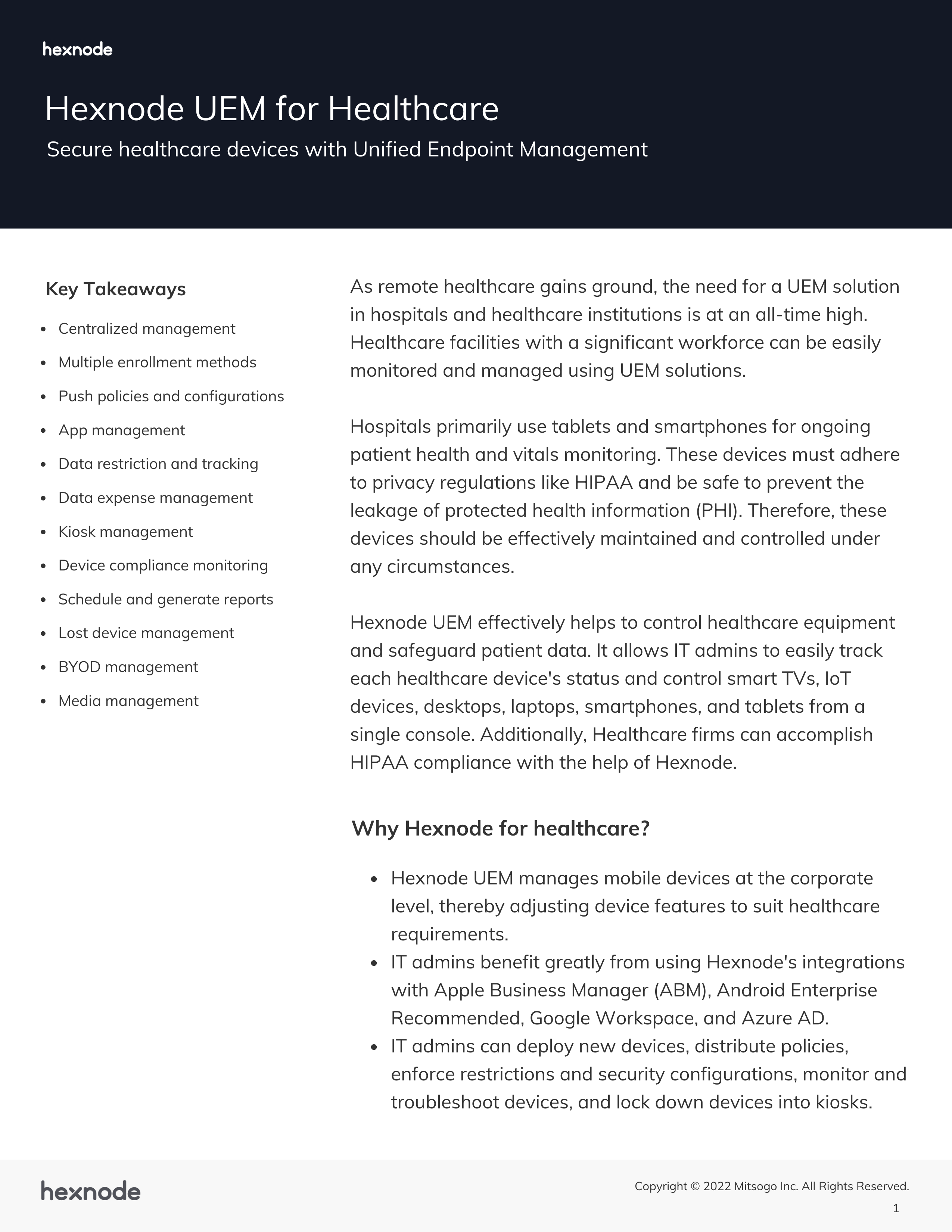How to secure and manage mobile devices in healthcare during the COVID 19 pandemic?
Securing mobile devices in healthcare institutions is a tedious task. Check out this blog to learn how you can achieve it.

Get fresh insights, pro tips, and thought starters–only the best of posts for you.

Ladies and gentlemen, boys and girls, how’s it going? I’ve been A-okay. I got myself a full-body checkup the other day. Why, you ask? Well, why not? After all, just a couple of weeks ago, the entire world was hyped up, celebrating World Health Day on the 7th of April. Whew! 75 years of the World Health Organization and look at how far we’ve come in terms of healthcare, technology, and of course, technology in healthcare.
Anyhoo, my visit to the hospital made me realize one thing, the healthcare program is a whole lot more than doctors, nurses, patients, and medicines. The sheer number of people that enter an ER in an hour is enough to fill up sheets and sheets of data. We’ve seen the health sheets and patient records, all accessed from the tablets, the sleek kiosks just standing there to help you navigate the different departments and get the general information. And, of course, the cutting-edge tools used for surgery and whatnot are just at the surface of how much technology is a part of the healthcare industry.
I know, it’s a very out-of-the-blue title. But think about it. What kind of picture does your brain paint the second you think of a hospital, of course, excluding needles and bitter medicines 😉? Doctors running around with pagers, gurneys rolling in and out of ER, and speakers blaring, ” Code blue on level 4,” or even, “Dr. Shepherd to OR 2.” This is what, I’m guessing most of you imagine, or at the very least, something along the lines of it. Good! All this build-up, only to get you thinking about pagers!
So yes, pagers. A pager, also known as a beeper, is a small radio device that can send and receive short messages. Until recently, doctors would use these pagers to communicate. Now, however, mobile phones are increasingly replacing these pagers.
Not only that, remember the thick patient files that the medical residents had to lug around from room to room? Yup, sleek and efficient tablets have now replaced those thick files. There is no denying the fact that mobile devices have dipped their toes into the pool of healthcare. So, of course, when these mobile devices weave themselves into the healthcare industry, the next big question is, “Which is the best operating system to power the mobile devices in the healthcare industry.”
Globally, Android is the major shareholder (70.88% as of March 2023) of the mobile operating system market share. Being a crowd-favorite, both for the general public and the nine-to-fivers, Android is also a popular choice for powering mobile devices in healthcare. Everything, from its flexibility and efficiency to value-for-money features, is what appeals Android to the healthcare industry. And so, Android in healthcare…
Why Android? Well, apart from being a crowd-favorite, Android has a lot more to offer. Chance a glance…
One of the best things that Android offers the healthcare industry is its flexibility in customization. The Android operating system allows healthcare organizations to tailor the user interface to suit their unique needs. No wonder Androids are more intuitive and user-friendly for medical professionals. Customizations could involve anything and everything from creating custom workflows to adding specialized healthcare apps that can improve efficiency and patient outcomes. Moreover, Android’s open-source nature enables developers to modify the operating system at the code level, providing a level of customization not available in other mobile platforms.
The security features in Android are an added bonus for the healthcare industry. With the amount of sensitive patient data being transmitted, it’s essential to have robust security measures in place. Android’s sandboxing technology helps isolate apps, so if one app is compromised, it cannot access data from other apps on the device. Additionally, encryption ensures that all patient data is protected both in storage and during transmission. Android’s regular security updates help protect against known vulnerabilities, minimizing the risk of data breaches and unauthorized access.
Compatibility is as important a criterion as any for all healthcare technologies. And this is something that Android understands very well! With a wide range of healthcare apps available on the Google Play Store, healthcare providers can easily find and install the apps they need to improve patient care. Android also supports a variety of third-party hardware, making it easier to integrate with other healthcare technologies, such as medical devices or electronic health record systems.
Accessibility is, indeed, crucial in healthcare. Android’s accessibility features can help medical professionals better communicate with their patients. For example, Android’s TalkBack screen reader feature helps users with visual impairments navigate their devices using spoken feedback. Android also supports hearing aids and cochlear implants, allowing medical professionals to communicate more effectively with patients who are deaf or hard of hearing. Furthermore, Android’s color contrast settings and font size options can help patients with visual impairments better navigate healthcare apps and interfaces.
Android’s value-for-money attitude is something any mobile user would swear by. When it comes to cost-effectiveness, Android devices are often less expensive than Apple devices. This makes them a more attractive option for healthcare organizations on a budget. With the wide range of Android devices available, healthcare organizations can find the right device for their needs without any hassle. Additionally, Android devices are often more durable and have longer battery life, reducing the need for frequent replacements and repairs.
So you see, the customization, security, compatibility, accessibility, and cost-effectiveness of Android make it an ideal choice for healthcare organizations looking to improve patient care and streamline workflows. With the ability to tailor the user interface, protect sensitive data, support a wide range of healthcare apps, and provide accessibility features, Android can help medical professionals deliver better patient outcomes while keeping costs under control. So, why not Android?

Get started with Hexnode’s device management solution to monitor and maintain your Androids in the healthcare industry.
Download datasheetThere are a lot of ways you can work with Androids in healthcare. Here’s a peek…
Oookayyy, that is, indeed, a very valid question. Mobile devices have already ventured into the healthcare industry. So, what even are we discussing? We’ve already established that Android is an amazing choice for the OS that powers these mobile devices. But, it doesn’t end there. The real headache is managing and securing these endpoints. Thankfully, we know how to tackle this headache. The answer’s pretty simple – Unified Endpoint Management. All sorts of industries are turning towards the different UEM solutions in the market, so why should the healthcare industry be left behind?
Hexnode is a comprehensive UEM solution that enables organizations to manage their entire device fleet from a single console. Its powerful features include device management, security management, application management, content management, and more. It provides a holistic approach to managing Android devices, enabling healthcare organizations to ensure compliance with industry regulations and safeguard sensitive patient information. Securing the Androids in healthcare has many angles to it. Let’s have a look at them…
With Hexnode, healthcare organizations can manage their Android devices using Mobile Device Management (MDM) protocols. This allows for remote control of device settings, configurations, and policies. For example, healthcare IT staff can set up and enforce passcodes on devices to ensure they are secure. They can also configure device settings such as network access, screen timeout, or disable certain features that may pose a security risk. Hexnode provides comprehensive device management capabilities, allowing healthcare organizations to configure, provision, and manage their Android devices. These include:
Hexnode offers a range of security features for Android devices in healthcare. For example, they use AES encryption for device data, ensuring that patient data remains secure even if a device is lost or stolen. Additionally, two-factor authentication can be set up to add an extra layer of security for device access. Hexnode also offers remote device wipe capabilities, which can erase data on a lost or stolen device, further ensuring patient data is protected. Healthcare organizations must ensure the security and privacy of patient data. Hexnode’s security management features enable healthcare organizations to:
Hexnode’s App Management feature allows healthcare organizations to manage and distribute apps across all their Android devices. Hexnode also enables the IT team to customize an app store with all the apps that may be required by healthcare personnel. This allows the healthcare team to download the required app directly from the customized app store as and when required. And so, this allows healthcare providers to access and install only the apps that they need for their specific roles. In addition, IT staff can configure app settings such as permissions and restrictions, ensuring that sensitive data is protected. And so, with Hexnode, healthcare organizations can:
Hexnode’s Content Management feature allows healthcare providers to access and share sensitive patient data in a secure and compliant way. Healthcare IT staff can distribute content such as patient charts, x-rays, or medical records to specific devices or groups of devices. Content can also be remotely wiped from a device if it is lost or stolen. Hexnode’s content management features enable healthcare organizations to:
Hexnode’s Remote Support feature allows IT staff to provide support to healthcare providers, even if they are not in the same physical location. This is where remote view and control come into play. IT staff can diagnose and troubleshoot issues remotely, reducing the need for physical intervention on the device. This minimizes device downtime and ensures that healthcare providers can continue to provide high-quality patient care.
Quite the conversation, right? Was it unexpected? Maybe. Was it a breeze and informative? I sure hope so! To put it in a nutshell, Android devices offer a wide range of possibilities for improving healthcare delivery and patient outcomes. From accessing medical records to tracking health data, Android devices are a powerful tool for healthcare professionals looking to enhance the quality and efficiency of their services. And while Android continues to wow the healthcare industry, Hexnode’s here to take up the mantle to efficiently manage and secure Android devices. So, rest easy and enjoy the benefits of Android in healthcare!
Want to get your trusted Androids ready to aid providing the best for your patients? Don't worry Hexnode's here to help!
Join now